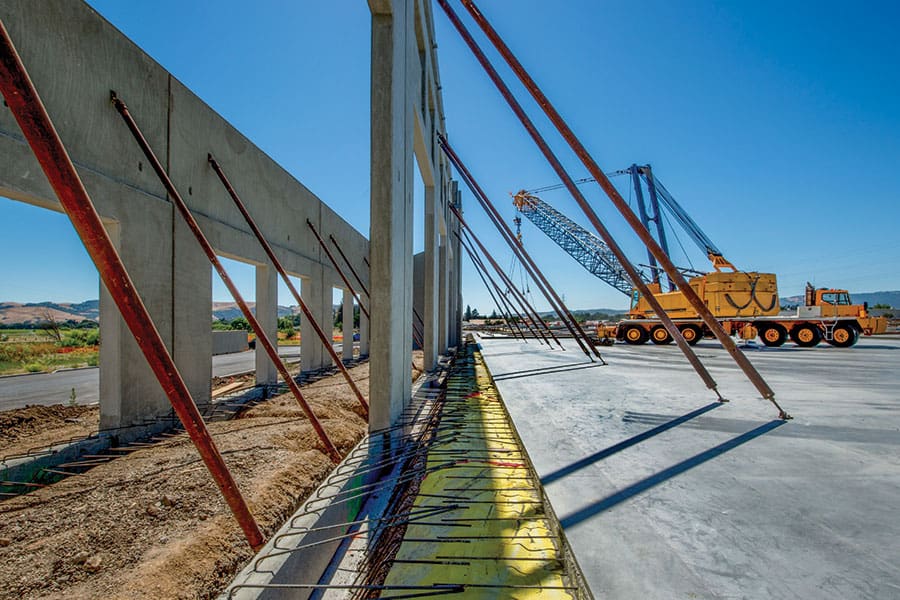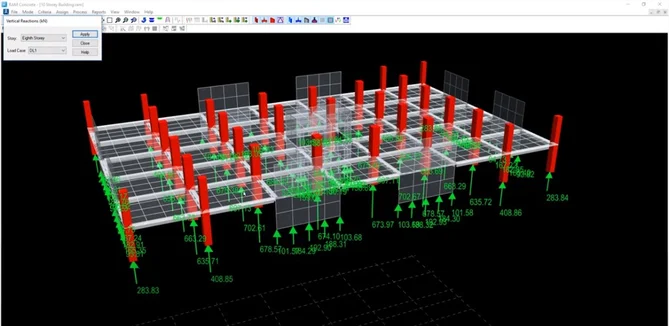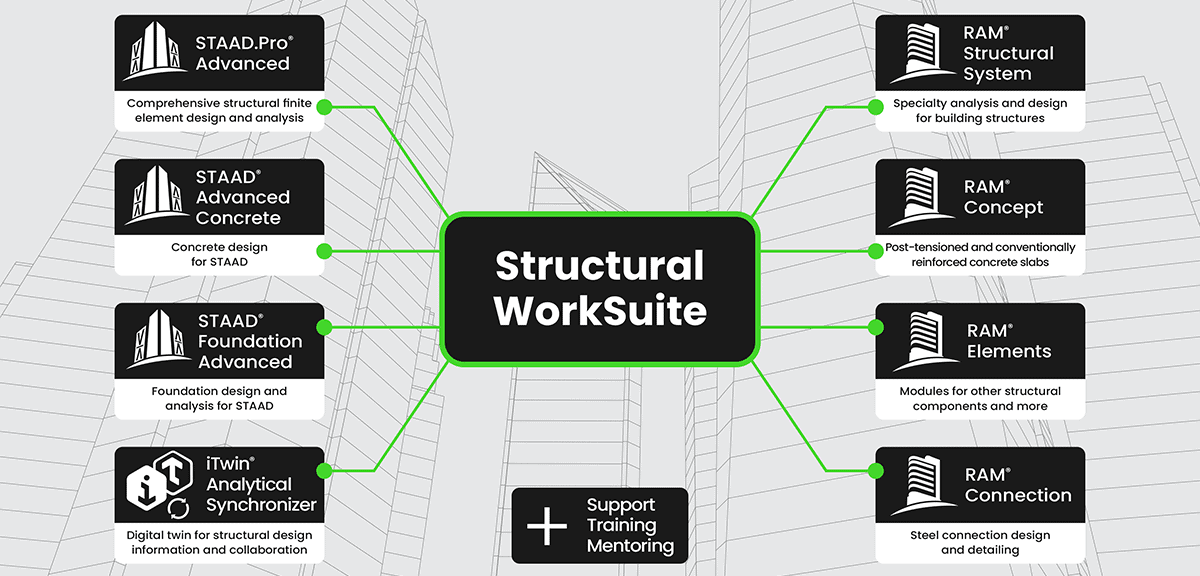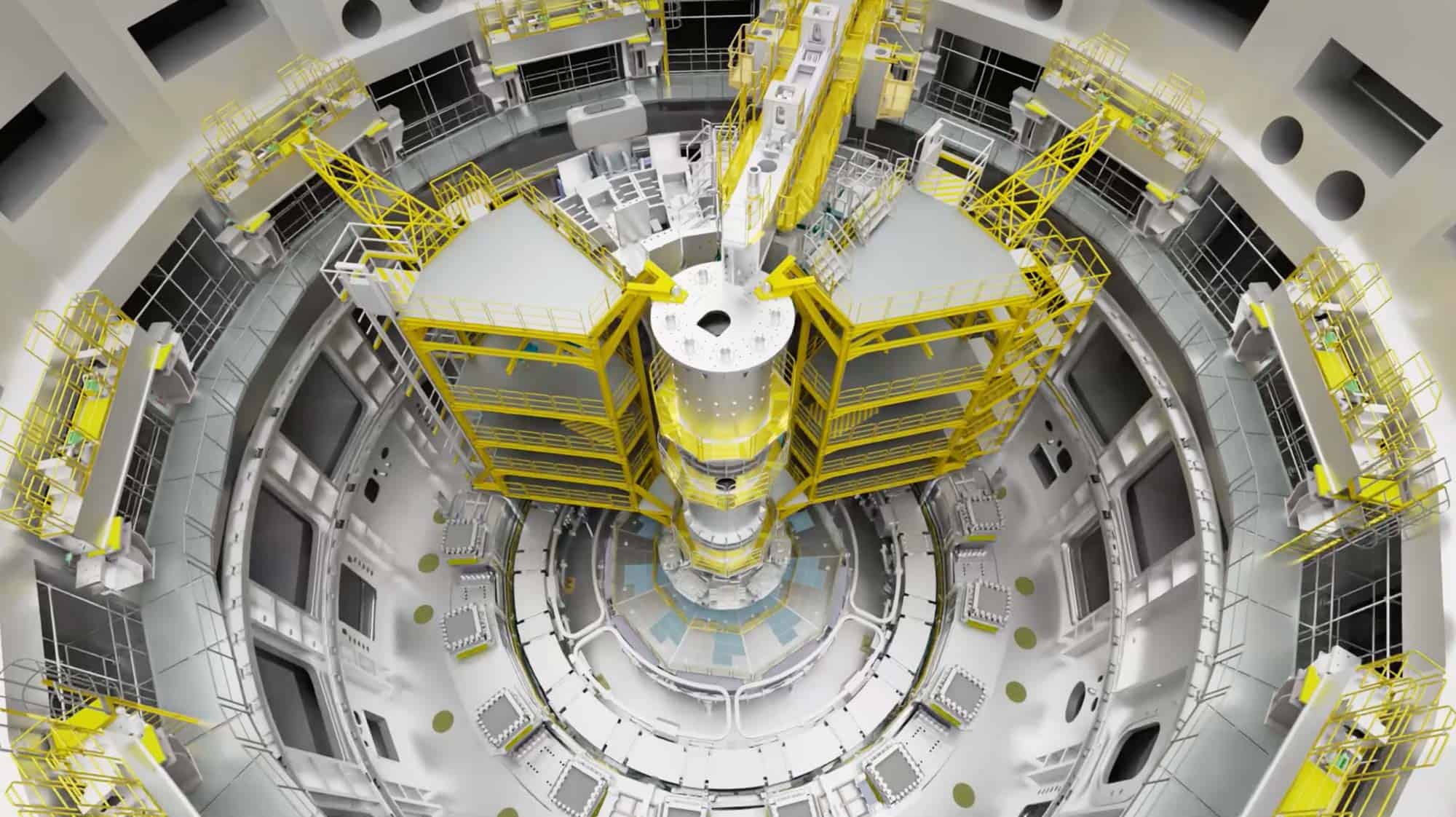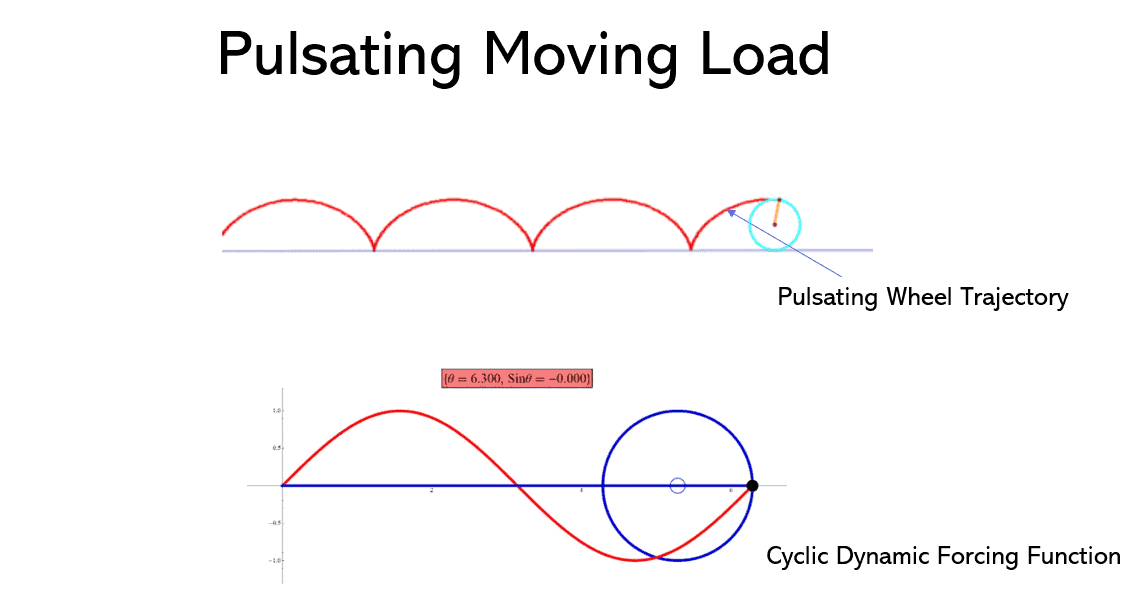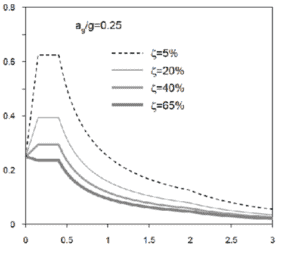Due to RAM Structural System’s reputation as a market leader for the design of steel structures, engineers tend to associate the software only with its steel design capabilities. But there are many concrete analysis and design tools available in RAM Structural System, and its integration link with RAM Concept helps engineers efficiently design concrete structures.
RAM Structural System offers a complete solution for the analysis, design, and documentation of concrete and steel building structures. It includes many time-saving features designed specifically for the analysis and design of buildings that are not available in many general-purpose finite element analysis applications.
Equilibrium load paths in concrete structures are often sensitive to member stiffness, which is closely associated with cracking, applied loading, reinforcement design, displacement of supporting members, and other factors. Given typical project schedule and budget constraints, many concrete designers perform a single analysis with assumed, code-specified stiffness factors (“cracked section factors”) to achieve a code-compliant design. As these cracked section factors are rough approximations, some designers choose to consider a range of stiffness values to confirm their design is not heavily dependent upon the accuracy of the stiffness assumptions.
This article focuses on the analysis capabilities of RAM Structural System and RAM Concept and how they can streamline your concrete design workflows. Specific topics covered in the article include:
- The different analysis types available in RAM Structural System.
- Productivity features in RAM Structural System and RAM Concept that are specifically designed for concrete structures.
- An example design workflow that illustrates how the different analyses and options can be leveraged by concrete designers.
Analysis Types and Options in RAM Structural System
RAM Structural System uses several different analysis types that are intended for specific engineering design tasks. The following sections break down each analysis type and discuss how they are utilized for reinforced concrete design.
RAM Concrete
The RAM Concrete analysis is based on ACI 318-19 6.3.1.2, which states that gravity load effects for column, beam, and slab design can be determined using a single floor analysis that includes the supports above and below the level that are fixed at the far ends. The analysis is completed level-by-level from the top to the bottom of the structure, with reactions for a given level automatically added as applied loads on the level below.
The analysis assumptions in RAM Concrete are useful for engineers who prefer to check or envelope column, wall, and foundation designs using tributary gravity loads, which are less sensitive to member stiffness. A transfer floor, which deflects due to load transfer from the members it supports, is one example of a structure type that is sensitive to overall 3D effects and force redistribution due to changes in member stiffness. Because RAM Concrete analyzes one floor at a time and assumes a rigid vertical support at the base of columns and walls below the floor, the analysis forces more closely match those from a tributary analysis than a full 3D finite element analysis.
Other RAM Concrete analysis options and features that concrete designers find helpful include:
- Automatic live load patterning. RAM Concrete includes an option to automatically generate skip live load cases to satisfy the requirements in ACI 318-19 6.4.2. There is also an option to pattern live load polygons that are applied to two-way slabs.
- Ignore stiffness of walls above the floor. RAM Concrete includes an option to ignore the stiffness of walls above the floor being analyzed. This option is useful for walls supported by transfer beam, because it prevents the wall from stiffening the beam or transferring load directly to column and wall supports.
- Eccentricity of pinned beam reactions. RAM Concrete automatically considers the eccentricity of pinned beams that frame into concrete columns. This is accomplished by shortening the physical beam length to the face of the column and adding a rigid link that transfers the beam reaction to the column centerline. A practical application for this option is the design of columns supporting precast concrete beams. This option combined with the skip live load option ensures that the columns are designed for the maximum unbalanced moment.
Figure 1 – Floor Reactions from the RAM Concrete Analysis
RAM Frame
The RAM Frame Analysis is a fully three-dimensional finite element analysis of the lateral force resisting system (e.g., moment frames, braced frames, and shear walls) for both gravity and lateral load cases. By default, the analysis excludes gravity beams, columns, and walls. However, there is an option to include gravity columns and walls that support two-way slabs for the gravity load cases. Floor diaphragms can be defined as rigid, semirigid, or flexible, with options to include or exclude the out-of-plane stiffness of two-way slab diaphragms for the lateral load cases. The analysis also includes a non-iterative P-Delta method that considers all applied gravity loads and self-weight of the structure. Unlike the floor-by-floor analysis in RAM Concrete, the RAM Frame analysis captures the overall 3D behavior and redistribution of gravity forces due to deflection of transfer beams and slabs.
Other analysis features in RAM Frame that are useful for concrete structures include:
- Construction stage analysis to account for differential axial shortening of supports and the corresponding moments induced in the supported elements as the construction of the structure progresses.
- Advanced iterative analysis to capture the P-Delta effects of slender concrete walls subject to out-of-plane pressures.
- Contour plots and cross section result reports for reviewing stresses and forces in meshed slabs and walls.
RAM Steel
RAM Steel performs a simple tributary analysis that considers all floor members as simply supported and statically determinate. In the analysis:
- Distributed loads are determined based on one-way deck spans and tributary area.
- Reactions due to the distributed loads are calculated.
- Reactions are transferred as applied loads to supporting beams or column.
Exclusion of two-way decks and indeterminate beams are two important limitations with this analysis.
Although the RAM Steel analysis is used mainly for the design of steel beams and columns, it is also important for the analysis and design of concrete structures in RAM Structural because:
- It is used to calculate applied loads on lateral members under one-way decks in RAM Frame.
- It can be selected as the preferred source of transfer gravity loads when importing RAM Structural System models into RAM Concept. This is especially useful for podium slabs supporting light framed bearing walls, for which simple load takedowns that ignore the stiffness of the bearing walls are desired.
RAM Concept
RAM Concept is a separate application that designs conventionally reinforced and post-tensioned concrete floors and mat foundations. It is linked directly to RAM Structural System through an integrated, bi-directional data exchange.
RAM Concept completes a single floor analysis that is similar to the RAM Concrete analysis. Its capabilities also include a rigorous, non-linear load history analysis for long-term deflection calculations and a comprehensive dynamic analysis for walking-induced vibration response.
Examples of time-saving features available through the RAM Structural System-RAM Concept link and the RAM Concept analysis include:
- Import of lateral load effects and a lateral self-equilibrium analysis. When the out-of-plane stiffness of slabs are considered to be part of the lateral load path in the RAM Frame analysis, the slab and the slab-column connections need to be designed for the forces and moments determined in the analysis. RAM Concept imports the resultant forces of supports directly above and below a given floor and analyzes those sets of forces using a special self-equilibrium analysis. This analysis ensures that the load path assumed in each analysis is consistent without any manual effort.
- Export of support reactions. Column reactions for gravity loadings and post-tensioning effects can be exported from RAM Concept into RAM Structural System and considered in the column design routines in RAM Concrete.

Figure 2 – Importing a RAM Structural System Model into RAM Concept
Example Concrete Design Workflow
The Commentary to ACI 318-19 6.3.1.1 states the following regarding the relative stiffness assumed in analysis models to account for cracking and the inelastic behavior of concrete members:
“Separate analyses with different stiffness assumptions may be performed for different objectives such as to check serviceability and strength criteria or to bound the demands on elements where stiffness assumptions are critical.”
As mentioned previously, a transfer slab supporting multi-level columns and/or walls is one example of a structure type that is often sensitive to member stiffness assumptions. Poor cracked stiffness assumptions in structural models of these floors may result in unintended force redistributions and unconservative designs.
Enveloping the force and moment demands from different analyses based on different cracked section factors is one method to ensure a safe, conservative design of such structures. The different analysis types available in RAM Structural System and the direct integration link between the products help engineers quickly design for such an envelope. The following outlines this type of workflow for a concrete structure:
- Model the two-way slab, columns, and walls with the cracked section factors outlined in ACI 318-19 6.6.3.1.1.
- Complete RAM Frame analysis and check drift using the analysis results.
- Import the floor into RAM Concept using the option to ignore cracked section factors modeled in RAM Structural System.
- Design the floor slab in RAM Concept for gravity and lateral loads imported from RAM Structural System.
- Export RAM Concept column and wall reactions to RAM Structural System.
- Complete RAM Concrete analysis using RAM Concept reactions.
- Design columns in RAM Concrete Column using gravity forces from RAM Concrete. These gravity forces will represent the RAM Concept results that are based on full stiffness.
- Save/freeze column designs.
- Change the gravity design force preference option in RAM Concrete Column to use gravity forces from RAM Frame instead of RAM Concrete and check designs. These gravity forces will represent the RAM Frame results that are based on the cracked stiffness factors.
- Design shear walls in RAM Concrete Wall. The walls will be designed for gravity and lateral forces from the RAM Frame analysis.
RAM Structural System and RAM Concept in Action
Structural engineers depend on the RAM products for their concrete design capabilities and their ability to handle a variety of structure and material types. DCI Engineers shared the following about their work on the Park 12 project, a 37-story concrete tower with adjacent 6-story concrete podium structures, recently completed in San Diego:
“Using Bentley’s innovative structural applications, DCI was able to produce an optimized design that minimized material use and maximized design efficiency. RAM Concept and RAM Structural System gave our team the ability to model the concrete and steel with ‛real world’ accuracy. This drastically increased the design’s efficiency and constructability …
“Bentley RAM is truly the best analysis and design software on the market for concrete and steel. The helpful user interface and on-hand customer service allows engineers to feel confident with their analysis and gives clear and understandable information. RAM has saved hundreds of hours of design time resulting into more efficient and better quality design that allows for easy back checking and transfer of information to our clients.”
– DCI Engineers

Figure 3 – DCI Engineers, Ball Park Village
Learn more about STAAD and RAM with Virtuosity:
Attend the webinar series: Register here
Discover the Reinforced Concrete Design with STAAD and RAM series featuring blogs and webinars
For the price and the amount of Keys included in RAM Virtuoso Subscription, please RAM Structural System’s.
Want to learn more about what STAAD and RAM can do for you? Don’t hesitate to contact our structural experts. We are happy to help.
